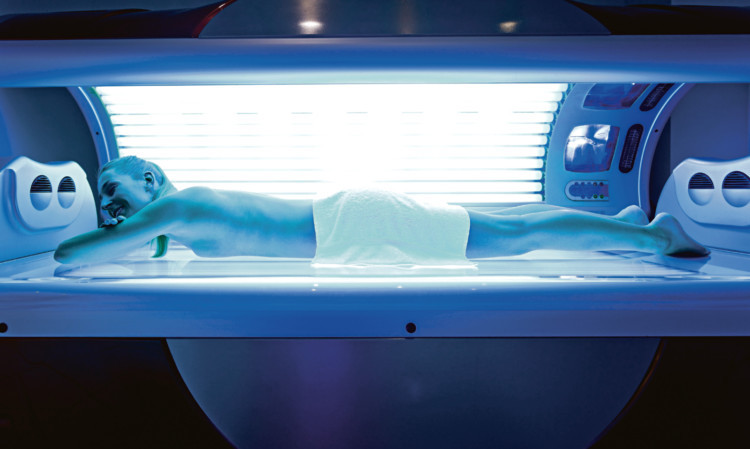
Councils have been accused of putting lives at risk by failing to monitor the strength of super-powered sunbeds.
A Sunday Post investigation has uncovered health and safety inspectors in at least 11 local authority areas aren’t checking whether tanning bed lamps are pumping out dangerously high levels of UV rays.
The revelation comes after a study found some sunbeds are twice as likely to cause skin cancer than a holiday in the Mediterranean.
Research probing sunbed usage also found one in 20 children, some as young as 12, admitted using them in 2013.
Lisa Adams, of Cancer Research UK, admitted the findings were a concern.
She said: “It’s worrying to see that so many sunbeds are not being checked to make sure they’re meeting the safety standards.
“The beds are not going to do you any good, the best case scenario is that they’ll age and damage your skin and the worst case is a cancer diagnosis.”
Safety laws put a legal emissions limit of 0.3 watts per square metre, the equivalent of the midday summer sun in Spain.
However, surveys by trading standards inspectors south of the border have shown many tanning salons are routinely flouting the regulations. In the worst case, output of UV rays breached the limit by as much as four times, a level which does not naturally occur anywhere on earth.
Our probe found at least 11 of Scotland’s 32 councils don’t check the operating wattage of tanning salon machines, including local authorities in Aberdeen, Dundee, Edinburgh and Glasgow.
Worringly only six could categorically confirm over the past five years, they have tested the UV levels within salons.
Among them inspections have taken place in Aberdeenshire, Dumfries and Galloway and South Lanarkshire.
While in South Ayrshire one premises was found to have five sunbeds emitting rays above the legal limit of radiation.
Other issues uncovered included owners failing to prevent UV overexposure causing clients to burn, staff leaving salons while customers used sunbeds, and electrical sockets in a state of disrepair.
Three councils, Angus, Fife and Renfrewshire, also reprimanded salon owners for letting children use their sunbeds, while in Aberdeen two salons were found to have beds “too hot to use”.
However, when asked about UV testing, a spokesman said: “Aberdeen City Council will only carry out checks on receipt of complaints relating to the equipment.”
The remaining councils claimed they either didn’t hold the information on whether sunbed wattages are checked or did not reply, meaning the number of areas with salons breaking the law could be far higher.
Leigh Smith, of Melanoma Action and Support Scotland, said: “We were speaking in one Glasgow school where, in a class of 20 kids, 10% said they used sunbeds.
“Sunbeds are a Class 1 carcinogen just like cigarettes, so those offering their use must be licensed just as strictly as those selling cigarettes.”
A European standard on UV radiations levels was introduced in 2003, it was followed by 2009 regulations limiting the amount of UV radiation permitted to no more than 0.3 watts per metre squared.
But a probe by this newspaper last year revealed 70% of sunbeds tested in the north of England breached the limit.
Gary Lipman, of the Sunbed Association, which represents salons, manufacturers and distributors of sunbeds, said it was “disappointing” many Scottish councils aren’t carrying out similar surveys.
He said: “We lobbied for this standard for many years but sadly it has met with deliberate indifference.
“Only trading standards offices have the authority to check and enforce compliance.
“We have provided training courses on this topic and we have another one taking place next month. At this point, we do not have any Scottish delegates registered to attend.”
Andy Foster, of the Trading Standards Institute, said it takes matters concerning product safety seriously.
But he added it’s unrealistic to expect all sunbeds to be tested by trading standards.
He said: “The UK’s consumer protection system is designed to put the obligation of safety on the businesses who supply such services.”
Scotland’s minister for public health Michael Matheson admitted the Scottish Government has “long-standing concerns” about sunbed use.
He said: “A number of councils already operate licensing schemes for tanning salons, and the Scottish Government will continue to work with councils to encourage wider adoption of licensing schemes.”
The councils who admitted not carrying out the checks all defended their stance.
A spokesman for Glasgow City Council said: “We do not carry out ‘safety check’ per se, in that a business would ‘pass or fail’.
“We conduct inspections under the Health and Safety At Work Act 1974 and raise any relevant issues with the business.”
A Dundee City Council spokesperson said: “Our trading standards officers will always respond to complaints about sunbeds, however the council does not routinely test them nor any other consumer products in general use. There is no legal obligation to test sunbeds on a routine basis.”
A Edinburgh City Council spokesperson added: “Testing is not carried out as a matter of routine and is not a legal obligation, but any complaints about sunbeds would be investigated.”
Report by Euan McLelland and Graham McKendry

Enjoy the convenience of having The Sunday Post delivered as a digital ePaper straight to your smartphone, tablet or computer.
Subscribe for only £5.49 a month and enjoy all the benefits of the printed paper as a digital replica.
Subscribe